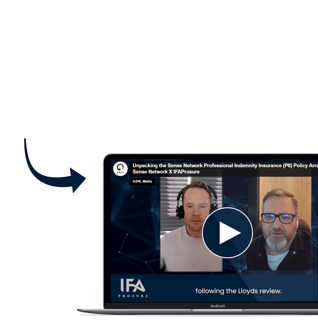 Watch the original video with Jonathan Newell and John Netting of IFAProsure, as they discuss the current landscape of the PII market and unpack the benefits of the Sense block policy arrangement.
Watch the original video with Jonathan Newell and John Netting of IFAProsure, as they discuss the current landscape of the PII market and unpack the benefits of the Sense block policy arrangement.
An Introduction to PII In 2023
Professional Indemnity Insurance (PII) is a crucial safeguard for professionals and businesses. It offers protection from financial losses stemming from claims of professional errors or negligence. PII covers legal expenses and compensation payments when clients or third parties allege that a professional's advice or services resulted in financial harm. The cost varies based on factors like profession and coverage level, and deductibles may apply. PII is an essential risk management tool for maintaining a professional's reputation and financial security.
Setting the scene
It might be a good starting point, before we look at the FCA data which was recently published on PII premiums, to go back in time a few years to 2018 and maybe set the scene for PII.
2018 was quite a seismic period. Specifically, Lloyds undertook a performance review of professional indemnity insurance and found that two thirds of its syndicates were loss making.
That created ripples across the industry and it resulted ultimately, in a PII crunch, where the review meant that several syndicates and companies either pulled out of the PII market completely or it meant at best, that those who remained really limited how much capacity they allocated to their to their PII teams. The end result was a real pinch point in terms of supply around PII and I hasten to add, this is very broad and across PII as a whole, internationally and across all professions not just in financial services.
The reality is that the market is still recovering from that. It has stabilised a lot in recent times and arguably a lot of uncertainty has now been removed. But in 2018, 2019 and even 2020 It was a very precarious time.
As a result of that review, capacity providers have become a lot more conscious that they underwrite for profit. It would seem as though we are unlikely to see a soft market any time soon. However, we can all hold out hope for a more stable outlook.
The FCA Retail Intermediary Data
That may be a good scene setter to lead into the key discussion point of this article, which is the recently published FCA data.
If you go right back to the data from 2017, the FCA was showing a range of average PIIs from 1.9% up to 2.7%, and that's for firms with turnover between anywhere from £100,000 turnover to £10,000,000 turnover.
We've seen that steadily increase over the years, with the recent data from the FCA ranging from 3.2% to 3.5%. A steady and significant increase over that time period.
It is true to say that the heavy rise in rates is related to market risk as well as the generic requirements for the PII rates to increase. The other factors that are keeping rates a bit higher or rather, preventing them from coming down substantially, are the consistent rises reinsurance costs that underwriters and insurance companies bear as well as inflation and social inflation.
However there is no denying that 3.2% to 3.5% of turnover, which is arguably the highest it's ever been for firms with over half a £500,000 to £10,000,000 turnover, could have a great impact on financial advice firms nationwide.
Recently there has been market commentary about rates seemingly coming down, but the FCA's Intermediary Data doesn’t necessarily support that. It is even more unlikely to suggest that the rates will return to pre-Lloyds review levels. There hasn’t been a rush back of capacity in PII and certainly not in financial services.
So there are some external factors which are keeping rates certainly buoyant and in the short to medium term, it seems unlikely that we will see a significant downturn in rates happening. Hopefully we can at least expect a more stable outlook over the coming months and years.
Historically, insurers also relied upon investment returns across their portfolio, so they would invest their pots of premium into various vehicles and indices, whatever it may be and they would rely on that income as well to keep their combined loss ratio at a reasonable level.
The volatility of the markets over recent years, has meant a shift towards looking a lot more closely and with a lot more scrutiny on underwriting profit, with less reliance on investment returns across the portfolios as well. The reality is that the insurance market is a creative one, they always find ways around issues like this.
but for Financial Advisers, ensuring the best rate for compliant and robust PII cover is a critical aspect of their risk management strategy. With the current landscape of the PII market and the challenges faced by insurers, it becomes even more important for Financial Advisers to carefully navigate the market and secure the most favourable rates for their professional indemnity insurance.
Get in touch to find out more.
.jpg?width=290&name=aa%20SENSE%20(356).jpg)


